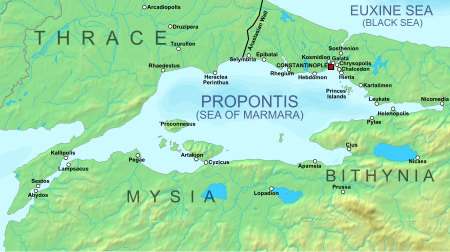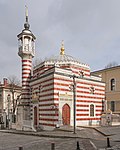Siege of Constantinople (674–678)

The first Arab siege of Constantinople in 674–678 was a major conflict of the Arab–Byzantine wars, and the first culmination of the Umayyad Caliphate's expansionist strategy towards the Byzantine Empire, led by Caliph Mu'awiya I. Mu'awiya, who had emerged in 661 as the ruler of the Muslim Arab empire following a civil war, renewed aggressive warfare against Byzantium after a lapse of some years and hoped to deliver a lethal blow by capturing the Byzantine capital, Constantinople. As reported by the Byzantine chronicler Theophanes the Confessor, the Arab attack was methodical: in 672–673 Arab fleets secured bases along the coasts of Asia Minor, and then proceeded to install a loose blockade around Constantinople. They used the peninsula of Cyzicus near the city as a base to spend the winter, and returned every spring to launch attacks against the city's fortifications. Finally, the Byzantines, under Emperor Constantine IV, managed to destroy the Arab navy using a new invention, the liquid incendiary substance known as Greek fire. The Byzantines also defeated the Arab land army in Asia Minor, forcing them to lift the siege. The Byzantine victory was of major importance for the survival of the Byzantine state, as the Arab threat receded for a time. A peace treaty was signed soon after, and following the outbreak of another Muslim civil war, the Byzantines even experienced a period of ascendancy over the Caliphate. The siege left several traces in the legends of the nascent Muslim world, although it is conflated with accounts of another expedition against the city in 669, led by the future Caliph Yazid I. As a result, the veracity of Theophanes's account was questioned in 2010 by Oxford scholar James Howard-Johnston, and more recently by Marek Jankowiak. Their analyses have placed more emphasis on the Arabic and Syriac sources, but have drawn different conclusions about the dating and existence of the siege. On the other hand, echoes of a large-scale siege of Constantinople and a subsequent peace treaty reached China, where they were recorded in later histories of the Tang dynasty.
Excerpt from the Wikipedia article Siege of Constantinople (674–678) (License: CC BY-SA 3.0, Authors, Images).Siege of Constantinople (674–678)
Hükümet Konağı Caddesi, Istanbul
Geographical coordinates (GPS) Address Nearby Places Show on map
Geographical coordinates (GPS)
| Latitude | Longitude |
|---|---|
| N 41.0122 ° | E 28.976 ° |
Address
İstanbul Valiliği
Hükümet Konağı Caddesi
34110 Istanbul
Türkiye
Open on Google Maps







